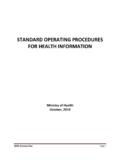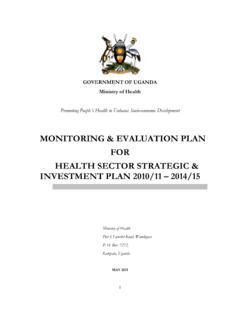Transcription of Policy Guidelines on Infant and Young Child Feeding
1 Policy Guidelines on Infant and Young Child FeedingJANUARY 2009 Policy Guidelines on Infant and Young Child FeedingJANUARY 2009iUganda Policy ForewordiiiAcknowledgementivAcronymsvExp lanation of TermsviiExecutive SummaryxChapter One: Overview Of Infant And Young Child Importance of optimal Infant and Young Child Global Current National Policies and Justi Goal and Objectives6 Chapter Two: Policy Issues7 the Child under Normal circumstances Aim and 3 Policy issues the Child who is exposed to HIV Aim and 3 Policy issues FeedingtheChildwhoisinOtherExceptionally Dif cultCircumstances Aim and Policy Issues 19 Chapter Three: Implementation, Monitoring And Advocacy and Social Capacity Information Education and Communication (IEC) Care and Counselling and Integration, Coordination and Strengthening growth monitoring and promotion (GMP) including screening 26and Resource Mobilisation and 1 2 Sources of and Cabinet, Parliament and Judiciary.
2 29 Table Of ContentsiiUganda Policy Ministry of Health Care Hospital Lower Level Health Ministry of Education and Universities and Tertiary Health Training Ministry of Labour Gender and Social Ministry of Agriculture, Animal industry and Ministry of Trade and Uganda National Bureau of Local Governments at District Non-Governmental, Community Based and Religious Political leaders The Private Sector and All United Nations Agencies (UNICEF, WHO, UNFPA, UNDP, FAO, UNAIDS, WFP) 35 Other Bilateral Agencies and Development PartnersChapter Four: Supportive Baby Friendly Health Facility Initiative Summary of the Main Provisions of The Food Safety (Marketing of 38 Infant and Young Child Foods) Regulations Maternity Protection Rights and Bene ts (ILO Maternity Protection 38 Convention 183 of 2000) Cup Hand Expression of Feeding Low Birth Weight Practical Steps to Ensure Appropriate Infant and Young Child Feeding 46In EmergenciesReferences49 Annexes52 Annex 1: List of Contributors 53 Annex 2.
3 List of Participants at the Meeting to Reach Consensus on the Use of 54 Cow Milk for Infants Less than Six Months of Age Convened by the Ministry of Health on 21 March, 2008iiiUganda Policy The critical value of optimal Infant and Young Child Feeding ( iycf ) has been recognised for decades, and over the last 25 years tremendous effort has been directed towards the promotion, protection and support of such optimal Feeding . Challenges do exist, however, especially since the discovery that breastfeeding is one of the modes of Mother-to- Child Transmission (MTCT) of the Human Immunodeficiency Virus /Acquired Immunodeficiency Syndrome (HIV/AIDS). The Government of Uganda has put in place several policies and programmes in its a empt to promote, protect and support optimal iycf .
4 In 2001, the government disseminated Policy Guidelines on the Feeding of Infants and Young Children in the Context of HIV/AIDS . At the global level, the World Health Organization (WHO) and the United Nations Children s Fund (UNICEF) published The Global Strategy for iycf , and The Framework for Priority Action in 2002. Since that time, however, additional scientific evidence has become available, suggesting that exclusive breastfeeding for up to six months decreases the risk of HIV transmission compared to non-exclusive breastfeeding. Studies published in the last few years indicate that early cessation of breastfeeding (before six months) is associated with an increased risk of Infant morbidity (especially diarrhoea) and mortality in HIV exposed children. A2006 WHO consensus meeting on iycf in the context of HIV/AIDS provided further guidance based on these findings.
5 Uganda has taken note of these developments in the current Policy Guidelines . These Policy Guidelines on iycf update and comprehensively address the issues related to Feeding of infants and Young children. They are intended for use by planners, managers and implementers who are involved in the provision of maternal and Child health, reproductive health and HIV/AIDS treatment, care and support. I therefore call upon all stakeholders in iycf to take and utilize these Policy Guidelines to their maximum advantage, to integrate the recommendations into their programs and to fund the necessary interventions listed herein, in order to contribute to a reduction of Infant and Young Child malnutrition, morbidity and mortality. The Ministry of Health will continue to coordinate and monitor the implementation of these Policy Guidelines and progress made towards achieving optimal iycf in Uganda.
6 ForewordDr. Sam ZarambaDirector General of Health ServicesMinistry of Health Government of UgandaivUganda Policy The Ministry of Health would like to very sincerely thank the United Nations Children s Fund (UNICEF), the World Health Organization (WHO), the World Food Program (WFP), the United States Agency for International Development (USAID), the University Research Co., LLC (URC) Nulife Program, the Regional Centre for Quality of Health Care (RCQHC), the Food and Nutrition Technical Assistance (FANTA) Project and the International Baby Food Action Network (IBFAN) for the technical and financial support which was so essential to fuel the development of these comprehensive Uganda Policy Guidelines on Infant and Young Child Feeding .Sincere gratitude is extended to all the members listed in Annex 1 and 2 for their contribution in the development of this document from the time of its inception through the final stages.
7 The process has been very labour intensive and the development would not have been possible if it were not for the untiring efforts and commitment of these individuals. Special recognition is made of IBFAN for the skilled technical guidance extended to the entire development process; all of the members of the Maternal and Child Health Cluster, Senior Management Commi ee, Health Policy Advisory Commi ee and Top Management Commi ee of the Ministry of Health for their technical input in refinement of this document; and to the URC/NuLife Program for layout design and editorial , the Ministry of Health wishes to thank all those stakeholders not mentioned by name, who in one way or another, either individually or collectively, contributed to the development and finalization of this National Policy Guidelines on Infant and Young Child Policy AcronymsAFASSA cceptable, Feasible, Affordable.
8 Sustainable and Safe ANCA ntenatal CareAIDSA cquired Immunodeficiency SyndromeARVA ntiretroviral DrugsARTA ntiretroviral TherapyBMSB reast Milk SubstitutesBFHIBaby Friendly Health facility InitiativeCBOC ommunity Based OrganizationCRCC onvention on the Rights of the ChildEBME xpressed Breast MilkENAE ssential Nutrition ActionsFANTAFood and Nutrition Technical AssistanceFAOFood and Agricultural OrganisationGMPG rowth Monitoring and PromotionHBCHome Based CareHC IVHealth Centre IVHIVH uman Immunodeficiency VirusHMISH ealth Management Information SystemIECI nformation, Education and CommunicationHPACH ealth Policy Advisory Commi eHSSPH ealth Sector Strategic PlanILOI nternational Labour OrganizationIMAMI ntergrated Management of Acute MalnutritionIMCII ntegrated Management of Childhood IllnessesIMRI nfant Mortality RateIBFANI nternational Baby Food Action NetworkIYCFI nfant and Young Child FeedingLBWLow Birth WeightIUInternational UnitsMDGM illennium Development GoalMOHM inistry of HealthMTCTM other-to- Child Transmission of HIV infectionMPCM aternity Protection ConventionMUACMid Upper Arm CircumferenceNCHSN ational Centre for Health StatisticsNGONon Governmental OrganizationNuLifeFood and Nutrition Interventions for Uganda PMTCTP revention of Mother-to- Child Transmission of HIV infectionRFReplacement FeedingviUganda Policy UNGASSU nited Nations General
9 Assembly Special Session on ChildrenUNHCRU nited Nations High Commission for RefugeesUNICEFU nited Nations Children s FundUPHOLDU ganda Program for Human and Holistic DevelopmentURC University Research Co. , LLCUSAIDU nited States Agency for International DevelopmentVCCTV oluntary Confidential Counselling and TestingWFPW orld Food ProgramWHAW orld Health AssemblyWHOW orld Health OrganizationRCQHCR egional Centre for Quality Health CareSAMS evere Acute MalnutritionTFCT herapeutic Feeding CentreUDHSU ganda Demographic and Health SurveyUHTUtra Heat TreatedUNAIDSU nited Nations AIDS ProgramUNDPU nited Nations Development ProgramUNFPAU nited Nations Fund for Population ActivitiesviiUganda Policy AFASS Acceptable: The mother perceives no significant barrier(s) to choosing a Feeding option for cultural or social reasons or for fear of stigma and discrimination.
10 Feasible: The mother (or other family member) has adequate time, knowledge, skills, and other resources to prepare feeds and to feed the Infant as well as the support to cope with family, community, and social pressures. Affordable: The mother and family, with available community and/or health system support, can pay for the costs of the replacement feeds including all ingredients, fuel and clean water without compromising the family s health and nutrition spending. Sustainable: The mother has access to a continuous and uninterrupted supply of all ingredients and products needed to implement the Feeding option safely for as long as the Infant needs it. Safe: Replacement feeds are correctly and hygienically stored, prepared, and fed in nutritionally adequate quantities; infants are fed with clean hands using clean utensils, preferably by cups.







